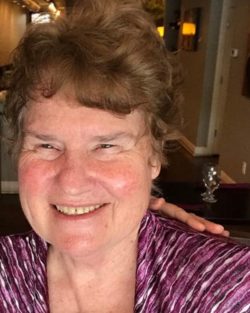September, 2023 Monthly Reflection
September 1, 2023
Healing Through the Body
Kathleen Bryant RSC
Have you ever smelled something and your whole being takes you immediately back to a memory? Or you are touched in a certain way and memories flood back. Maybe you feel anxiety growing in a particular situation as your body tries to get your attention with body tension or pain. At times our wise, even if broken, bodies are trying to tell us something.
Our bodies hold our memories and our traumas. This year I took a course on Trauma and Wellness provided by Spiritual Directors International. I listened and learned from 13 different therapists and experts conscious of our AEHT work with survivors. One of the tips I picked up was to avoid using the word “trigger” and to substitute “activated by”. Although I will never fully comprehend the depth of the trauma experienced by a survivor of trafficking, the course broadened my understanding of chronic trauma and how we respond as we listen. Trauma consciousness is the realization that we are unable to cope, especially when activated by memories, flashbacks, or body sensations.
Body work is essential. Some years ago I received a grant to study resilience in thrivers who not only survived their experiences but became amazing leaders. Although I’m very conscious that boys and men are trafficked, this study and reflection is focused on women. So many of these women shared with me how body work helped in their healing whether it was yoga, running, dancing, therapeutic massage or even simple gardening and the physical act of creating through art and music. The well-known book, “The Body Keeps the Score: Brain, Mind, and Body in the Healing of Trauma” by Bessel van der Kolk M.D., heightens the sense of how important the body is in healing. Our body remembers details that we may not consciously be aware of and consequently can open us up to healing the whole person. Dr. van der Kolk documents how trauma actually changes our bodies and our brains.
Women shared how body work freed them for healing. One survivor said physical exercises helped her cope with the fatigue of PTSD. Another woman dances at work for the residents in a health care facility and dance enables her to tap into a joyful freedom. Aileen created her own plan which she describes as engaging her whole body, which included the gym, swim, and spa! For another gentle breath work and centering yoga was her way forward. Our AEHT member houses make these kinds of opportunities available for the women’s healing.
Self-care for those working in this field as advocates, mentors, and accompaniers was stressed in this course. We, too, may have unrecognized trauma that needs to be named and addressed before we can sensitively and tenderly respond to those whose trauma was trafficking. What healing practices for our vulnerable bodies are part of our daily lives? The stories of those we accompany can also activate our own painful memories. This might get in the way if we don’t do our own homework.
As we grow in self-awareness and graced embodiment, we will be more present to those we accompany. Listening to trauma stories can activate in us unresolved issues. As we care for our own bodies, they can awaken us and direct us to what needs attention. Do we have daily practices that help deepen our capacity for embodiment? Our own inner work improves our ability to walk with others and not let our own issues get in the way. Vicarious trauma also challenges us to be deeply grounded so we can be totally open to whatever precious person and story comes into our lives. As we attune and attend, we become safe places for others to share.
It is important to find a safe spot, or neutral one, on your own body for this grounding. If we deepen our safe spots we are more at home helping others to find a place of safety. Here is a simple exercise by Angie Fadel, a spiritual director who practices somatic methods of healing:
Place your hand on that tense spot – breathe
Now place your hand on your safe or neutral spot
Place your hand on that tense spot
Now place your hand on your safe or neutral spot
Place your hand on that tense spot – breathe
Now place your hand on your safe or neutral spot
Take a few on your own give at least a 5 breaths as a time allotment
Notice if you feel calmer and less tense, the more you practice this and techniques like this one on your own the more you can show up in all your other spaces with a calm body. (Angie Fadel)
There are many complex facets of PTSD, and the body is one reality, but it can lead to healing on other levels as well. This is what I have learned from thriving resilient women. In the end, we are taught by these women leaders and what better teachers for the sisterhood?

- Kathleen Bryant, RSC
Category: Monthly Reflections, The Alliance to End Human Trafficking

